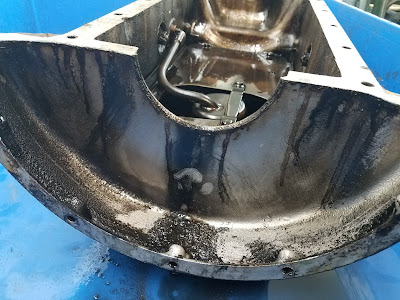PROJECT 51: The Oil Pan (Sump). What could Brutus possibly have screwed up on a cast aluminum oil pan with no moving parts? (Note to self: Don't ask questions you don't really want answers to.) To his credit, Brutus seems to have taken the splash-baffle and the pre-pump filter assembly out of the oil pan to clean everything up. Sadly (but not surprisingly) he then mated them back together using the wrongs bolts! And this is hardly the first instance of "mate-swapping" that I've encountered in the engine.
(Even when my memory was good I bagged and tagged fasteners as I took them off. Now, if I think it's going to be more than about fifteen minutes before I reassemble something, I take pictures and mark everything!)
In one of the photos, the shorter of the two longs bolts is the correct one. So, my concern is that somewhere on the engine there may be a bolt that is too short where the longer bolt actually belongs. I'll be paying very close attention during re-assembly.
Somehow, Brutus also managed to strip several (if not all) of the threaded holes that join the transmission's bell-housing to the end of the cast-aluminum oil pan. He "fixed" that by drilling and re-tapping them all to the next larger bolt size. (I would have used thread inserts.)
Apparently, when he was reinstalling the oil pan he must have had one bolt through the bell-housing into the pan, and dropped the pan. I'm surmising this because there is a previously-welded repair to the bell-housing, and the mating bolt hole in the oil pan was cracked open and stripped out. That hole had already been re-tapped, so I know it didn't happen during disassembly.
Ignoring that now-useless hole, Brutus went ahead and installed the oil pan, figuring that five bolts was almost as good as six. Then, at the opposite corner of the oil pan he installed a bolt that was too long, and it bottomed out in the hole. Undeterred, he kept cranking on the bolt to get that last turn or two, and he broke it off, re-stripping his newly re-tapped hole, and leaving the nub of bolt protruding from the inside of the hole. So then, four bolts became as good as six. Small British cars are known for their over-engineering anyway, right?
I had the crack welded, and the hole entirely filled, then I re-drilled and tapped the hole after using the bell-housing to spot its location. After removing the piece of broken bolt from the other hole using an easy-out, I fixed the stripped thread with an insert.
From the factory, the oil pan would have been painted the same red as the engine and gearbox, but paint doesn't stick to aluminum very well. So, most people who restore these cars to be drivers, as mine will be, leave the sump its natural aluminum. It's not highly polished, but I like the look, just the same.
 |
| Oil pan with splash-baffle and pre-pump filter still in place. |
 |
| Underside of oil pan. It had been painted green, at some point. Factory color would have been red. |
 |
| Flywheel-end of oil pan showing the evidence of the inevitable British-sports-car oil leaks. |
 |
| After painstaking(!) cleaning. |
 |
| The only time paint sticks well to aluminum is when you want to get it off. Lots of stripper and elbow grease to get to this point. |
 |
| Long bolts clamp the oil pick-up to the oil pump, so getting it right is critical. Short bolts hold the pre-pump filter assembly. Two different bolts and two different washers. (How hard can this be?) |
 |
| Debris found in the sludge in the bottom of the oil pan. This motor obviously had a serious malfunction at one time. |
 |
| Nub of broken-off bolt left in oil pan casting. |
 |
| Removing nub with an easy-out. Hole was later repaired with a thread insert. |
 |
| Inside view of split casting. |
 |
| Outside view of split casting. |
 |
| Previous repair to mating hole in bell housing. |
 |
| Outside after welding and sanding. |
 |
| Inside after welding and grinding. |
 |
| Using a transfer punch to mark the location of the new hole. |
 |
| Tapping the new hole. |
No comments:
Post a Comment